Contributed by: RAND
Description:
Students determine the forces necessary to move a truck on an
inclined plane with weight and slope as variables. They then apply
their understanding to identify the cheapest way to transport trash
to local garbage disposal sites.
The task assesses students' abilities to make simple observations,
design an experiment, collect and interpret data, and apply their
understanding to an additional situation.
This task is designed to take students approximately 45-60 minutes
to complete.
Overall Task Content Area:
- Physical Science
Specific Knowledge Areas:
- Inclined Planes
Performance Expectations:
- conducting investigations
- using equipment
- gathering, organizing, and representing data
- formulating conclusions from investigational data
- applying scientific principles to develop explanations and solve
new problems
National Science Education Standards:
4 A SI 1: Abilities necessary to do scientific inquiry:
Grades K-4
1.2 Plan and conduct an investigation. In the earliest years,
investigations are largely based on systematic observations. As
students develop, they may design and conduct simple experiments
to answer questions. The idea of a fair test is possible for many
students to consider by fourth grade.
1.4 Use data to construct a reasonable explanation. This
aspect of the standard emphasizes the studentsí thinking as they
use data to formulate explanations. Even at the earliest grade levels,
students should learn what constitutes evidence and judge the merits
or strength of the data and information that will be used to make
explanations. After students propose an explanation, they will appeal
to the knowledge and evidence they obtained to support their explanations.
Students should check their explanations against scientific knowledge,
experiences, and observations of others.
1.5 Communicate investigations and explanations. Students
should begin developing the abilities to communicate, critique,
and analyze their work and the work of other students. This communication
might be spoken or drawn as well as written.
4 B PS 2: Position and Motion of Objects: Grades K-4
2.3 The position and motion of objects can be changed by
pushing or pulling. The size of the change is related to the strength
of the push or pull.
(Use the "hot" link on the PALS home page
to check the full text of related National Science Education Standards,
if desired.)
National Council of Teachers of Mathematics:
AL3: Use mathematical models to represent and understand
quantitative relationships:
Grades pre K-5 b. model problem situations
with objects and use representations such as graphs, tables, and
equations to draw conclusions
AL4: Analyze change in various contexts:
Grades pre K-5 c. investigate how a change
in one variable relates to a change in a second variable
DAP1: Formulate questions that can
be addressed with data and collect, organize, and display relevant
data to answer them:
Grades pre K-5 e. collect
data using observations, surveys, and experiments
Grades pre K-5 f. represent data using tables
and graphs such as line plots, bar graphs, and line graphs
DAP4: Understand and apply basic concepts
of probability:
Grades pre K-5 b. predict
the probability of outcomes of simple experiments and test the predictions
MEAS1: Understand measurable attributes of objects and
the units, systems, and processes of measurement:
Grades pre K-5 e. understand such attributes as length, area,
weight, volume, and size of angle and select the appropriate type
of unit for measuring each attribute
PS2: Solve problems that arise in mathematics and in
other contexts:
Grades pre K-5
RP3: Develop and evaluate mathematical arguments and
proofs:
Grades pre K-5
COM3: Analyze and evaluate the mathematical thinking
and strategies of others:
Grades pre K-5
CON1: Recognize and use connections among mathematical
ideas:
Grades pre K-5
General Instructions to the Teacher:
This task is designed to take students approximately 45-60 minutes
to complete.
Students will be working individually during this exercise.
Students should be ready to work as soon as the period begins.
The materials should be set out at each lab station, if possible.
A central supply area, if needed, should be easily accessible. All
supplies should be clearly labeled.
Materials for Incline:
Standardized kits were used in the original administration of the
task. You may not be able to create your own materials to exactly
match those used in the original form of this performance task.
However, you may be able to come up with your own materials that
work just as well. The illustrations presented at the end of this
section are just suggestions and may or may not produce acceptable
results. (Your feedback about task or material modifications would
be appreciated.)
The teacher will need:
- ladders with 5 rungs and able to stand upright (These can be
built with Lego ™ pieces as shown below.)
- marking pen
- thin board, of width able to fit in between ladder posts (A
ruler may suffice.)
- toy trucks with load capacity
- washers
- hooks
- string
- small buckets
At this station students should have:
- ladder with labeled rungs
- plank
- toy truck with string and hook attached
- small bucket
- 35 metal washers
- 4 marbles- 2 large, 2 small
Advance Preparation:
- Construct a 5 runged ladder with Lego ™ pieces.
- Label the rungs "1" through "5" starting
at the bottom.
- Tape a Lego ™ piece to the reverse side of one end of the
ruler. This will keep the ruler from sliding when on a rung.
- Tape a crayon on the other side of the same end of the ruler.
This will reduce friction between the string and the end of the
ruler.
- Attatch one end of the string to the toy car and the other end
to a hook for the bucket.
Safety:
- Be careful.
- Teachers and students should always exercise appropriate safety
precautions and utilize appropriate laboratory safety procedures
and equipment when working on science performance tasks.
Extensions/modifications:
This photo depicts the set up used for RAND's Incline administration.
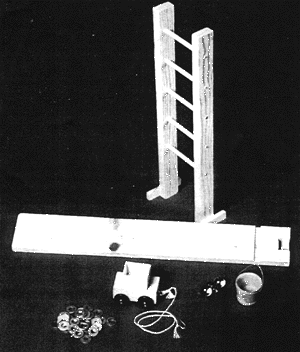
These images describe one possible way to create your own materials
for Incline.
- Build a "ladder" with Legos ™ with sufficent space
between rungs.
 |
- Number and label rungs starting from the bottom of the
ladder.
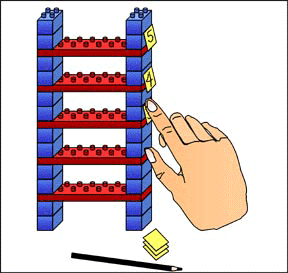 |
- Tape a block on the underside of one end of the ruler
to keep the ruler from sliding off the ladder rungs.
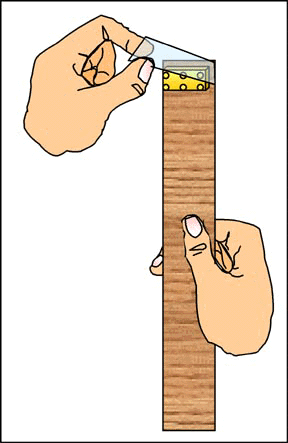 |
- Tape a crayon on the front of the same end of the ruler
to reduce friction between the string and ruler.
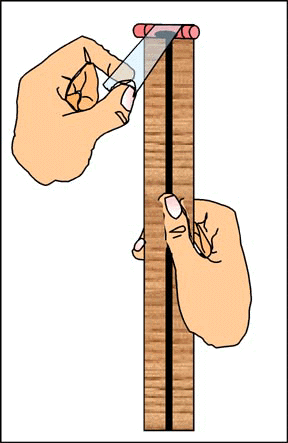 |
- Be sure ladder rungs have enough space inbetween for apparatus.
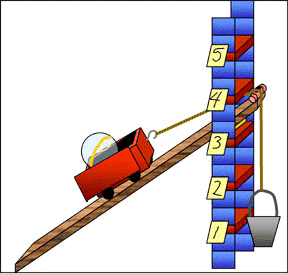
|
|
|







